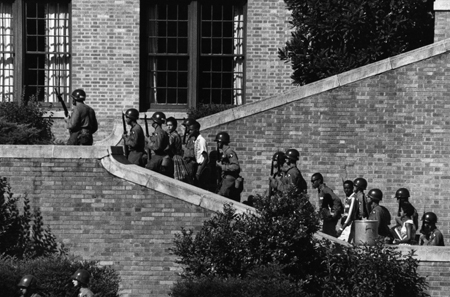| << Chapter < Page | Chapter >> Page > |
As schools strive to fill a variety of roles in their students’ lives, many issues and challenges arise. Students walk a minefield of bullying, violence in schools, the results of declining funding, plus other problems that affect their education. When Americans are asked about their opinion of public education on the Gallup poll each year, reviews are mixed at best (Saad 2008). Schools are no longer merely a place for learning and socializing. With the landmark Brown v. Board of Education of Topeka ruling in 1954, schools became a repository of much political and legal action that is at the heart of several issues in education.
Until the 1954 Brown v. Board of Education ruling, schools had operated under the precedent set by Plessy v. Ferguson in 1896, which allowed racial segregation in schools and private businesses (the case dealt specifically with railroads) and introduced the much maligned phrase “separate but equal” into the U.S. lexicon. The 1954 Brown v. Board decision overruled this, declaring that state laws that had established separate schools for black and white students were, in fact, unequal and unconstitutional.
While the ruling paved the way toward civil rights, it was also met with contention in many communities. In Arkansas in 1957, the governor mobilized the state National Guard to prevent black students from entering Little Rock Central High School. President Eisenhower, in response, sent members of the 101st Airborne Division from Kentucky to uphold the students’ right to enter the school. In 1963, almost ten years after the ruling, Governor George Wallace of Alabama used his own body to block two black students from entering the auditorium at the University of Alabama to enroll in the school. Wallace’s desperate attempt to uphold his policy of “segregation now, segregation tomorrow, segregation forever,” stated during his 1963 inauguration (PBS 2000) became known as the “Stand in the Schoolhouse Door.” He refused to grant entry to the students until a general from the Alabama National Guard arrived on President Kennedy’s order.

Presently, students of all races and ethnicities are permitted into schools, but there remains a troubling gap in the equality of education they receive. The long-term socially embedded effects of racism—and other discrimination and disadvantage—have left a residual mark of inequality in the nation’s education system. Students from wealthy families and those of lower socioeconomic status do not receive the same opportunities.
Today’s public schools, at least in theory, are positioned to help remedy those gaps. Predicated on the notion of universal access, this system is mandated to accept and retain all students regardless of race, religion, social class, and the like. Moreover, public schools are held accountable to equitable per-student spending (Resnick 2004). Private schools, usually only accessible to students from high-income families, and schools in more affluent areas generally enjoy access to greater resources and better opportunities. In fact, some of the key predictors for student performance include socioeconomic status and family background. Children from families of lower socioeconomic status often enter school with learning deficits they struggle to overcome throughout their educational tenure. These patterns, uncovered in the landmark Coleman Report of 1966, are still highly relevant today, as sociologists still generally agree that there is a great divide in the performance of white students from affluent backgrounds and their nonwhite, less affluent, counterparts (Coleman 1966).

Notification Switch
Would you like to follow the 'Introduction to sociology 2e' conversation and receive update notifications?